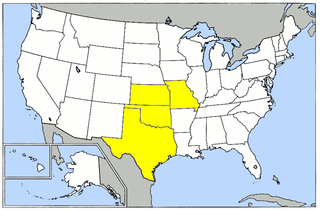- Ajo Army Airfield, Arizona
- AAF Flying Gunnery School (Fixed)
- 330th Gunnery Training Group
- Opened: August 1942, Closed: April 1945 (AT-6, AT-9) [3]
- Satellite of Luke Field; taken over by Williams Field, 1 July 1943
- Dateland Army Airfield, Dateland, Arizona
- AAF Advanced Flying School, Two-Engine
- Satellite of Yuma Army Airfield
- Airfield supported gunnery training, no permanent aircraft assigned
- Douglas Army Airfield, Douglas, Arizona
- AAF Advanced Flying School, Two-Engine, also Two-Engine Transition
- 310th Two-Engine Flying Training Group
- Opened: August 1942, Closed: November 1945 (AT-9, AT-17, UC-78, AT-24) [4]
- Aircraft carried fuselage code: "A"; [5] Became exclusive B-25 Mitchell and B-26 Marauder two-engine transition school October 1944, closed November 1945
- Echeverria Field, Wickenburg, Arizona
- AAF Contract Pilot School (Primary)
- 5th Glider Training Detachment
- Opened: October 1941, Closed: April 1944 (PT-17, PT-27, PT-13) [6]
- Operated by: Claiborne Flight Academy; Glider training Jan 1941 – Feb 1943; Primary flight training February 1943 – April 1944
- Gila Bend Gunnery Range, Gila Bend, Arizona
- AAF Flying Gunnery School (Fixed)
- Opened: September 1942, Closed: September 1944 (AT-6) [7]
- Satellite of Luke Field, operated AT-6s for gunnery practice
- Luke Field, Phoenix, Arizona
- AAF Advanced Flying School, Single-Engine
- AAF Advanced Flying School, Single-Engine (Transition)
- 330th Single Engine Flying Training Group
- Opened: March 1941, Closed: July 1946 (PT-17, AT-6, P-36, P-39, P-40) [8]
- Aircraft carried fuselage code "X"; [5] AT-6s flown from July 1941 until end of war; transition school operated P-36s (1941), P-39s, P-40s; Advanced Flying School closed July 1946; remained open as training base, becoming Luke Air Force Base in 1948.
- Marana Army Air Field, Marana, Arizona
- AAF Basic Flying School
- AAF Advanced Flying School, Single-Engine
- Opened: August 1942, Closed: August 1945 (BT-13, AT-6) [9]
- Aircraft carried fuselage code: "S"; [5] Became advanced single-engine school October 1944
| - Ryan Army Airfield, Tucson, Arizona
- AAF Contract Pilot School (Primary)
- 11th Flying Training Detachment
- Opened: July 1942, Closed: September 1944 (PT-17, PT-22, PT-27) [10]
- Operated by: Ryan School of Aeronautics, Hemet, California; transferred to United States Marine Corps, April 1945
- Thunderbird Field No. 1, Phoenix, Arizona
- AAF Contract Pilot School (Primary)
- 6th Flying Training Detachment
- Opened: September 1939, Closed: July 1945 (PT-13, PT-17) [11]
- Operated by: Thunderbird Corporation
- Thunderbird Field No. 2, Scottsdale, Arizona
- AAF Contract Pilot School (Primary)
- 12th Flying Training Detachment
- Opened: June 1942, Closed: October 1944 (PT-17) [12]
- Operated by: Thunderbird Corporation
- Williams Field, Chandler, Arizona
- AAF Advanced Flying School, Single-Engine
- AAF Advanced Flying School, Two/Four-Engine, also Two/Four-Engine Transition
- Opened: January 1942, Closed: June 1948 (AT-6, AT-9, AT-10, AT-11, AT-17, B-25, B-17, B-24) [13]
- Aircraft carried fuselage code: "Y" [5] Became single-engine AT-6 school in December 1943; Two/Four engine training beginning May 1945; became permanent USAF Williams Air Force Base, 1948. Closed 1993
- Yuma Army Airfield, Yuma, Arizona
- AAF Advanced Flying School, Single-Engine
- AAF Advanced Flying School, Two-Engine, also Two-Engine Transition
- 307th Single-Engine Flying Training Group
- Opened: November 1942, Closed: December 1945 (AT-6, AT-9, AT-17, UC-78, B-25) [14]
- Aircraft carried fuselage code: "U"; [5] Also operated Yuma gunnery and bombing ranges
|





















